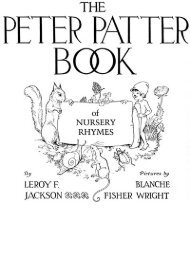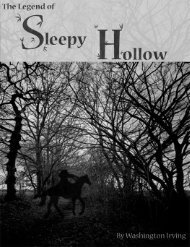The Elegant Art of Dining: Bohemian San Francisco, Its ... - iMedia
The Elegant Art of Dining: Bohemian San Francisco, Its ... - iMedia
The Elegant Art of Dining: Bohemian San Francisco, Its ... - iMedia
You also want an ePaper? Increase the reach of your titles
YUMPU automatically turns print PDFs into web optimized ePapers that Google loves.
Bohemia <strong>of</strong> the Present<br />
<strong>San</strong> <strong>Francisco</strong>’s care-free spirit was fully exemplified before the ashes <strong>of</strong> the<br />
great fire <strong>of</strong> 1906 were cold. On every hand one could find little eating places<br />
established in the streets, some made <strong>of</strong> abandoned boxes, others <strong>of</strong> debris from<br />
the burned buildings, and some in vacant basements and little store rooms,<br />
while a few enterprising individuals improvised wheeled dining rooms and went<br />
from one part <strong>of</strong> the city to another serving meals.<br />
<strong>The</strong> vein <strong>of</strong> humor <strong>of</strong> irrepressible effervescence <strong>of</strong> spirit born <strong>of</strong> <strong>Bohemian</strong>ism<br />
gave to these eating places high sounding names, and many were covered with<br />
witty signs which laughed in the face <strong>of</strong> Fate.<br />
Fillmore became the great business street <strong>of</strong> the city now in ashes, and here were<br />
established the first restaurants <strong>of</strong> any pretensions, the Louvre being first to<br />
open an establishment that had the old-time appearance. This was on the corner<br />
<strong>of</strong> Fillmore and Ellis, and had large patronage, it being crowded nightly with<br />
men and women who seemed to forget that <strong>San</strong> <strong>Francisco</strong> had been destroyed.<br />
Thompson opened a large restaurant in O’Farrell street, just above Fillmore, and<br />
for two years or more did a thriving business, his place being noted for its good<br />
cooking and its splendid service. One <strong>of</strong> his waiters, Phil Tyson, was one <strong>of</strong> the<br />
earlier ones to go back into the burned district to begin business and he opened<br />
a restaurant called the Del Monte in Powell street near Market, but it was too<br />
early for success and closed after a short career.<br />
Thompson enlisted others to join with him in opening a magnificent place<br />
under the new Flood building at the corner <strong>of</strong> Powell and Market street, but<br />
through faulty understanding <strong>of</strong> financial power Thompson was compelled to<br />
give up his interest and the place afterward closed. It has since been reopened<br />
under the name <strong>of</strong> the Portola-Louvre, where now crowds assemble nightly to<br />
listen to music and witness cabaret performances. Here, as well as in a number<br />
<strong>of</strong> other places, one can well appreciate the colloquial definition <strong>of</strong> “cabaret.”<br />
That which takes the rest out <strong>of</strong> restaurant and puts the din in dinner. If one<br />
likes noise and distraction while eating such places are good to patronize.<br />
Across the street from the Portola-Louvre at 15 Powell street is the modernized<br />
Techau Tavern now known as “Techau’s”. Here there is always good music<br />
and food well cooked and well served, and always a lively crowd during<br />
the luncheon, dinner and after-theatre hours. <strong>The</strong> room is not large but its<br />
32





